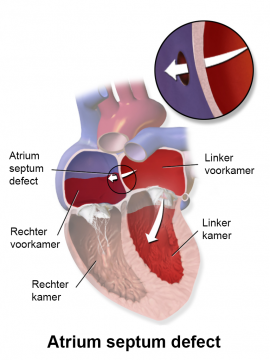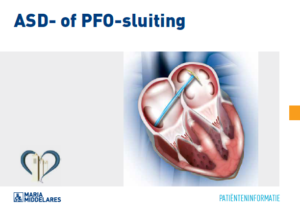Closure of an atrial septal defect (ASD)
What is it?
What is it?
An atrial septum defect is an opening between the left and right anterior chambers. In normal circumstances, this opening is closed during the development of the embryo. Such a defect may result in overload of the right atrium and an increase in pulmonary pressures. In the long term, this may also cause heart rhythm disturbances.
The goal of closing this ASD is to prevent this overload and even return the blood pressure in the lungs to normal levels. This procedure is never urgent.
What is the process?
What is the process?Preparation
You will be admitted to the Cardiology Department. You need to be fasting: that means at least two hours for clear fluids (only water, tea and coffee), at least six hours for a light meal and dairy products and at least eight hours for a regular meal. Medication may be taken as agreed with the physician.
You will be given a surgical gown to wear. Blood samples will be collected. The nurse will place an IV line in your arm to administer medication later.
The procedure is performed in the cardiac catheterisation room.
The procedure
You will take your place on the examination table. Adhesive electrodes are attached to monitor your heart rhythm. You will be given antibiotics through the IV drip as protection against infection.
The anaesthetist will prepare you for and then administer the anaesthesia. A tube will be placed in your throat to help you breathe. You will be covered with a sterile sheet. A probe will be inserted in the oesophagus to support the procedure.
Then, the physician punctures a vein in the groin to deliver the catheter up into the heart, through the defect. A balloon is used to determine the correct dimensions. After that, an umbrella-shaped device is put into place and the catheters are removed.
Aftercare
If all checks are satisfactory on the following day, you may go home. The procedure is generally estimated to require four days off work, but this depends on the degree of physical effort involved in the work.
What are the risks?
What are the risks?Complications are extremely rare but may have serious consequences. Some possible complications include:
- air embolism
- infection
- migration of the umbrella-shaped device
Results
ResultsOnce the device is placed, it will be covered with the patient’s own heart tissue. The enlargement of the right atrium can now begin to resolve.
Leaflet
LeafletSee the leaflet below for more information.
Only available in Dutch:

Sluiten Atrium Septum Defect (ASD)
DownloadCentres and specialist areas
Centres and specialist areas
Latest publication date: 16/05/2024
Supervising author: Dr Provenier Frank



